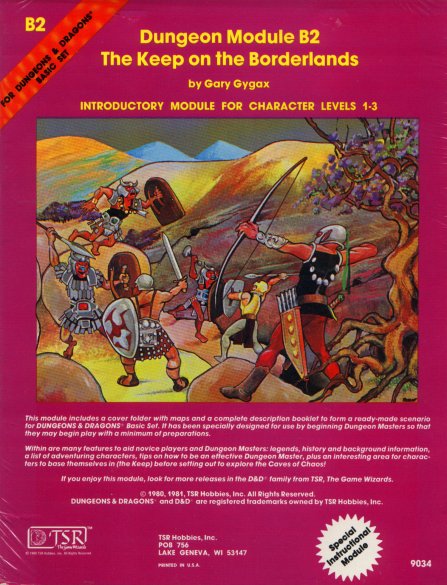The Keep on the Borderland
 Classic D&D adventure module review
Classic D&D adventure module review
The Keep on the Borderland, by Gary Gygax – Basic D&D, 1981
Introductory module for character levels 1-3
28 pages plus the separate cover with maps on the inside faces. The adventure has 64 numbered areas.
This module originally accompanied the Basic Dungeons & Dragons boxed set (1981, edited by Tom Moldvay). The first four pages of this module is an introduction to Dungeons & Dragons. There are notes for the Dungeon Master (DM) on reading monster and non-player character (NPC) stats in the module text, on running combats, on tracking time, and some general advice on how to be an effective DM.
The background on the setting of the Keep, and the starting set up, including a table of 20 rumors (true and false) the Player Characters (PCs) may know, begins on page 6. The information on the numbered areas of the Keep cover pages 8 – 12. Every structure in and about the Keep is described, and even each person statted out. It’s ironic that with all this detail, no one in the Keep is given a name—even the Keep itself has no name. Everyone from the innkeeper to the castellan is simply referred to by their job title.
The areas in the Keep are detailed down to the treasure hidden in personal rooms. The loan bank key includes the treasure stored in the cellar strong room—it’s full of valuable treasure, and would probably tempt most PC parties to at least consider a raid on it if they ever learned of it.
Pages 24 and 25 has a list of statted out NPCs, including personalities, advice for designing floor plans for buildings in the Keep, some tips for Players, and a glossary of non-game terms (like brazier and pot boy). Page 26 has a sample floor plan, (for the Keep Guild House), and pages 27 and 28 have a map of the Keep and the wilderness around the Keep, respectively.
Four wilderness encounter areas are described over a page and a half after the section on the Keep. The main adventure locale of this module is the Caves of Chaos, detailed on pages 14 – 23. The map for the Caves covers the entire inside cover of the book.
The dungeon complex is a moderately large set of caves in a ravine. Eleven entrances each lead to one set of caves occupied by different evil humanoid races, (kobolds, orcs, goblins, hobgoblins, gnolls, bugbears), a few individual monsters (ogre, minotaur, owlbear), and a temple full of undead.
Though some readers may have a difficult time accepting so many different and aggressively opposed creatures living in the same relatively small area, the arrangement does allow the invading PCs to take on small chunks of increasingly dangerous tribes, one at a time. If the PCs can determine what creatures live in which caves, they can choose to take on the kobolds first, then the goblins, then the orcs, etc., and work their way up to fighting the bugbear and minotaur when they gain a level or two. This is a good design decision for introducing novice Players to the game—they can encounter a wide variety of monsters in their first adventure. Some of the encounters consist of numerous enemies, and parties of less than the suggested six to nine PCs can find themselves in serious trouble.
Like many other adventure modules of this era, there is no boxed text to be read aloud to the Players. And like many other adventures by this author, the text is written in a stream of consciousness style, so the room description, monster combat stats, and treasure is all in the same paragraph with no organization. A DM must read through the areas before the game session to make notes and highlight information, because trying to read through it at the gaming moment will get confusing and will slow down the play.
All the monsters are listed in the “old school” stat block style: (AC 5, HD 2, hp 8 each, #AT 1, D 2-8, Save F 2, ML 8).
Overall, the adventure is broad selection of monsters for novice Players to experience. There is no stated or explained plot or specific background for the Caves of Chaos, so a DM will either need to make up something for his campaign, or else just hope the Players never wonder about it. With brand new D&D Players, it is quite possible that they may never think or care why there’s all these monsters in the caves, and why there’s a temple full of evil priests, skeletons, and zombies in the same locale.
But it is possible, maybe even probable, that the Players will ask for names of the various personages in the Keep. The author gives the combat stats for characters the PCs will probably never fight, but he didn’t give them names. The good thing about this lack of detail is that this module is generic enough to be truly modular, and can fit in just about any standard D&D campaign.
Bullgrit






 Categories:
Categories: 





